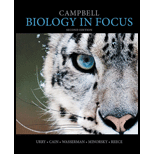
Concept explainers
In a comparison of birds and mammals, the condition of having four limbs is
- A. a shared ancestral character.
- B. a shared derived character.
- C. a character useful for distinguishing birds from mammals.
- D. an example of analogy rather than homology.
Introduction:
A shared ancestral character is referred to as a character that initially originated from an ancestor of a taxon. Therefore, such shared ancestral character is shared with other taxa that have an earlier last common ancestor. Common internal structures can be shared by two different organisms from different taxa, for examples, the limbs of birds and humans; flipper of a whale and wings of a bat; and the limbs of a bat and deer.
Answer to Problem 1TYU
Correct answer:
A shared ancestral character is inherited from a common ancestor and can appear anywhere in a phylogenetic tree, its presence does not confirm anything about the relationships within that tree. Therefore, option (A) is correct.
Explanation of Solution
Reason for correct statement:
A shared ancestral character is common in two lineages, for example, the limb of a human and bird. Both have a similar internal structure, but it cannot be inferred that humans are more closely related to birds than terrestrial vertebrates.
Option (A) is given as “a shared ancestral character”.
“In a comparison of birds and mammals, the condition of having four limbs is a shared ancestral character”, hence, it is the right answer.
Hence, option (A) is correct.
Reasons for the incorrect statements:
Option (B) is given as “a shared derived character”.
The shared derived character evolved in the lineage leads up to the clade and that places members of that clade apart from other individuals. Shared derived characters are used to group organisms into clades. Hence, it is a wrong answer.
Option (C) is given as “a character useful for distinguishing birds from mammals”.
As the shared ancestral character is one that is common in two taxa, but it cannot be inferred that humans are more closely related to birds than mammals. Hence, it is a wrong answer.
Option (D) is given as “an example of analogy rather than homology”.
As analogous organs have similar functions but different origins, whereas homologous organs have similar origin but different functions. Hence, it is a wrong answer.
Hence, options (B), (C), and (D) are incorrect.
In the comparison of birds and mammals, the condition of having four limbs is a shared ancestral character that shows the two taxa shared by a common ancestor.
Want to see more full solutions like this?
Chapter 20 Solutions
Campbell Biology in Focus (2nd Edition)
Additional Science Textbook Solutions
Biological Science (6th Edition)
Chemistry & Chemical Reactivity
Genetics: From Genes to Genomes
Campbell Essential Biology (7th Edition)
- Not part of a graded assignment, from a past midtermarrow_forwardNoggin mutation: The mouse, one of the phenotypic consequences of Noggin mutationis mispatterning of the spinal cord, in the posterior region of the mouse embryo, suchthat in the hindlimb region the more ventral fates are lost, and the dorsal Pax3 domain isexpanded. (this experiment is not in the lectures).a. Hypothesis for why: What would be your hypothesis for why the ventral fatesare lost and dorsal fates expanded? Include in your answer the words notochord,BMP, SHH and either (or both of) surface ectoderm or lateral plate mesodermarrow_forwardNot part of a graded assignment, from a past midtermarrow_forward
- Explain in a flowcharts organazing the words down below: genetics Chromosomes Inheritance DNA & Genes Mutations Proteinsarrow_forwardplease helparrow_forwardWhat does the heavy dark line along collecting duct tell us about water reabsorption in this individual at this time? What does the heavy dark line along collecting duct tell us about ADH secretion in this individual at this time?arrow_forward
 Concepts of BiologyBiologyISBN:9781938168116Author:Samantha Fowler, Rebecca Roush, James WisePublisher:OpenStax College
Concepts of BiologyBiologyISBN:9781938168116Author:Samantha Fowler, Rebecca Roush, James WisePublisher:OpenStax College
 Human Biology (MindTap Course List)BiologyISBN:9781305112100Author:Cecie Starr, Beverly McMillanPublisher:Cengage Learning
Human Biology (MindTap Course List)BiologyISBN:9781305112100Author:Cecie Starr, Beverly McMillanPublisher:Cengage Learning Biology Today and Tomorrow without Physiology (Mi...BiologyISBN:9781305117396Author:Cecie Starr, Christine Evers, Lisa StarrPublisher:Cengage Learning
Biology Today and Tomorrow without Physiology (Mi...BiologyISBN:9781305117396Author:Cecie Starr, Christine Evers, Lisa StarrPublisher:Cengage Learning Biology: The Dynamic Science (MindTap Course List)BiologyISBN:9781305389892Author:Peter J. Russell, Paul E. Hertz, Beverly McMillanPublisher:Cengage Learning
Biology: The Dynamic Science (MindTap Course List)BiologyISBN:9781305389892Author:Peter J. Russell, Paul E. Hertz, Beverly McMillanPublisher:Cengage Learning Comprehensive Medical Assisting: Administrative a...NursingISBN:9781305964792Author:Wilburta Q. Lindh, Carol D. Tamparo, Barbara M. Dahl, Julie Morris, Cindy CorreaPublisher:Cengage Learning
Comprehensive Medical Assisting: Administrative a...NursingISBN:9781305964792Author:Wilburta Q. Lindh, Carol D. Tamparo, Barbara M. Dahl, Julie Morris, Cindy CorreaPublisher:Cengage Learning





